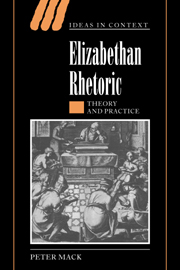Book contents
- Frontmatter
- Contents
- Acknowledgements
- Introduction
- 1 Rhetoric in the grammar school
- 2 Rhetoric and dialectic at Oxford and Cambridge
- 3 English-language manuals of rhetoric and dialectic
- 4 Everyday writing: notebooks, letters, narratives
- 5 Histories, conduct manuals, romances
- 6 Political argument
- 7 Elizabethan parliamentary oratory
- 8 Religious discourse
- Conclusion
- Bibliography
- Index of rhetorical and dialectical terms
- General index
- IDEAS IN CONTEXT
1 - Rhetoric in the grammar school
Published online by Cambridge University Press: 22 September 2009
- Frontmatter
- Contents
- Acknowledgements
- Introduction
- 1 Rhetoric in the grammar school
- 2 Rhetoric and dialectic at Oxford and Cambridge
- 3 English-language manuals of rhetoric and dialectic
- 4 Everyday writing: notebooks, letters, narratives
- 5 Histories, conduct manuals, romances
- 6 Political argument
- 7 Elizabethan parliamentary oratory
- 8 Religious discourse
- Conclusion
- Bibliography
- Index of rhetorical and dialectical terms
- General index
- IDEAS IN CONTEXT
Summary
In order to understand the relationship between the literary culture which was inculcated in the grammar school and the norms of Elizabethan discourse, it is necessary to begin by analysing grammar school education as a whole. My aim in this chapter is to show how the individual parts of what was a pretty uniform national system came together to encourage a particular type of literacy and to transmit a shared heritage of cultural knowledge. T. W. Baldwin has shown that the founders of sixteenth-century grammar schools took their programme and their selection of classical and renaissance Latin set-books from continental humanists. Across England grammar schools shared the aim of making their pupils wise, pious and eloquent. In order to describe the expectations about reading and writing which all pupils acquired through this training, I shall analyse the shape of the grammar school programme, the methods of reading classical Latin texts which pupils were taught, and the forms and methods of composition they practised. This will enable me to outline at the end of the chapter the skills which we might expect pupils to have acquired from the whole process.
The grammar school cultivated particular skills in a range of different ways but it also emphasised a range of skills. Moral sentences formed the pupils' elementary reading matter in the Sententiae pueriles, which they learned by heart as examples of Latin syntax.
- Type
- Chapter
- Information
- Elizabethan RhetoricTheory and Practice, pp. 11 - 47Publisher: Cambridge University PressPrint publication year: 2002

